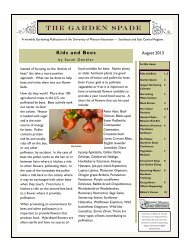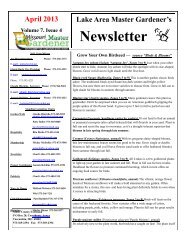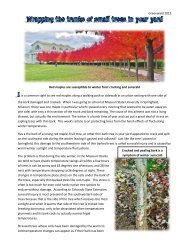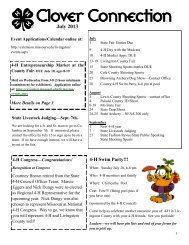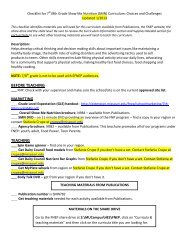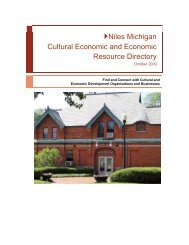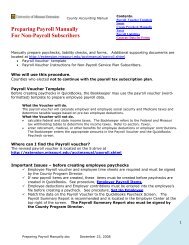Building Strong Families - University of Missouri Extension
Building Strong Families - University of Missouri Extension
Building Strong Families - University of Missouri Extension
Create successful ePaper yourself
Turn your PDF publications into a flip-book with our unique Google optimized e-Paper software.
<strong>Building</strong> <strong>Strong</strong> <strong>Families</strong><br />
equal opportunity/ADA institution<br />
Family Strengths Handout #2<br />
Having Fun with Your Family 365 Days a Year<br />
Family Survival Activities
<strong>Building</strong> <strong>Strong</strong> <strong>Families</strong><br />
Caring and Appreciation<br />
equal opportunity/ADA institution<br />
Family Strengths Handout #2<br />
Caring and Appreciation, Page 1<br />
Family members do positive things for one another just because they care.<br />
ACTIVITIES<br />
Caring Days: We all want to be loved in our own way. Family members<br />
themselves can tell us the special things that make them feel loved.<br />
Make lists <strong>of</strong> things that make you feel loved. Share your lists with family<br />
members and ask them to make a list <strong>of</strong> things that make them feel loved for all<br />
other family members.<br />
Begin having “Caring Days” on a regular basis. On each Caring Day, every<br />
family member picks one thing from each person’s list and does what it says.<br />
For example, if you pick backrub from someone’s list, you take time during<br />
Caring Day to give that person a back rub. If your daughter feels loved when you<br />
build sandcastles together, take some time on Caring Day to do that.<br />
Kindling Kindness. Kindness does not have to cost money. It can just be<br />
showing thoughtfulness and consideration. Make kindness a habit.<br />
Start by doing one kind act each day for a week, such as doing a chore for a<br />
family member, sitting with a new classmate at lunch or donating food and<br />
clothing to a local organization.<br />
Love Notes. Appreciation and love can help us feel good about ourselves. Love<br />
notes are one way to express those feelings and can help family members notice<br />
good things about each other.<br />
Suggest that family members recognize the things they like about each other.<br />
They may like the way a person behaves; admire their talents, skills, and<br />
achievements; or appreciate special qualities that make the person unique.<br />
Encourage all family members to express their feelings by writing short notes to<br />
each other about the things they notice. Tuck the notes under the person’s pillow<br />
or slip them into a backpack, lunch bag, briefcase, gym bag, or purse. Write at<br />
least one note to each family member every week.
equal opportunity/ADA institution<br />
Family Strengths Handout #2<br />
Caring and Appreciation, Page 2<br />
Pay attention to your children. Your children’s sense <strong>of</strong> self-worth influences<br />
their future. How they feel about themselves will affect their choice <strong>of</strong> friends,<br />
how they get along with others, and how well they use their abilities.<br />
Take time to talk to children, listen to them, and pay attention to their activities<br />
and interests. Find times when you are not hurried or tense and can focus on<br />
them.<br />
Express affection through physical contact. With babies this means holding<br />
and cuddling. As children get older, you can <strong>of</strong>fer hugs, kisses, caresses, an arm<br />
over the shoulder, or a pat on the back. Sometimes the right words are hard to<br />
find, but a gentle hug says it all.<br />
Treat children with the same respect you show adults. Too <strong>of</strong>ten we reserve<br />
one set <strong>of</strong> manners for adults, and another for children. We may embarrass our<br />
children by scolding or criticizing them in front <strong>of</strong> others. Or we may get so<br />
involved in a conversation we forget their presence. Children are no less<br />
sensitive than adults and deserve the same kind <strong>of</strong> respect.<br />
Tell children from time to time that they’re appreciated. Don’t wait until they<br />
get good grades or limit your praise to their good looks or manners. Let them<br />
know you enjoy them and think they’re great all the time.<br />
Respond to children with patience and understanding. When your child<br />
spills his milk for the third time in a row, or hits his sister over the head with a toy<br />
shovel, it’s easy to treat him as a criminal. Try, though, to see the child as<br />
someone who needs your help in controlling his body and emotions.<br />
Respect children’s feelings and abilities. Because <strong>of</strong> their size, we can forget<br />
that children are people, too. They have a right to privacy and feelings <strong>of</strong> their<br />
own. We may have to remind ourselves not to carry children when they can get<br />
there under their own steam or to speak for them when they can speak for<br />
themselves.
<strong>Building</strong> <strong>Strong</strong> <strong>Families</strong><br />
Time Together<br />
equal opportunity/ADA institution<br />
Family Strengths Handout #2<br />
Time Together, Page 1<br />
Finding time to get the family together can be difficult. With family members,<br />
schedule specific activities to ensure that the family finds time.<br />
ACTIVITIES<br />
Mealtime.. Plan for the family to be together for at least one meal each day.<br />
Involve everyone from the start with tasks such as setting the table or making<br />
salads. Turn <strong>of</strong>f the television. Put newspapers, work from the <strong>of</strong>fice, and other<br />
cares aside. Focus on topics that make mealtime fun.<br />
Invite family members to share interesting experiences, plans, upcoming events<br />
and news. Instead <strong>of</strong> rushing <strong>of</strong>f when the meal is finished, sit around the table<br />
and talk.<br />
Just the Two <strong>of</strong> Us. Make a point to spend special one-on-one time with each<br />
child monthly. List things you’d like to do, how much time they take, what you will<br />
need to do them, and how much each will cost.<br />
At the beginning <strong>of</strong> the month, schedule a date, choose an activity from the list,<br />
and mark it on the calendar. Adults need to remember to schedule monthly<br />
dates with each other as well as the children.<br />
My Very Own Book. It’s never too early to begin reading. Reading aloud to<br />
infants combines two <strong>of</strong> their favorite things--the wonderful sound <strong>of</strong> their<br />
parent’s voice and close personal contact.<br />
You can easily make your child an interesting, low-cost book from an empty<br />
photo album. Help your child collect pictures <strong>of</strong> family members, friends, favorite<br />
animals, toys, etc. Mix-up different sounds, colors, shapes, and activities.<br />
Variety encourages language development. You can also use pictures from<br />
magazines, photos, postcards, and catalogs.<br />
Fill the book, using one or two pictures per page. Albums with magnetic pages<br />
are sturdy, easy to keep clean and allow you to change pictures easily. Talk<br />
about the pictures and let your child rearrange them and add to them. This gift<br />
can grow with your child.
equal opportunity/ADA institution<br />
Family Strengths Handout #2<br />
Time Together, Page 2<br />
Little Sprouts. Your kids can learn about life from gardening. Like people,<br />
plants need love and care to grow. Food and water keep them alive, and extra<br />
acts <strong>of</strong> kindness help them thrive. Children also learn a sense <strong>of</strong> responsibility<br />
by watering and weeding plants.<br />
Try these fun ideas:<br />
Χ Put a marker with each child’s name beside the vegetable or flower<br />
he or she planted. After harvest, use the vegetable in a family meal<br />
and put the gardener’s name beside the serving dish (for example,<br />
Carol’s corn or Tom’s tomatoes).<br />
Χ Fill an old tennis shoe with potting soil and plant grass or flower<br />
seeds in it. Keep it moist and in 5 weeks you should have a fine<br />
crop <strong>of</strong> grass or flowers.<br />
Χ Children will love to share homegrown vegetables or flowers with<br />
neighbors, grandparents and others. Have them add a note that<br />
says “homegrown with love by….”<br />
Χ Care for the garden together with a positive attitude. Make it fun-not<br />
a punishment or a chore.<br />
Sow seeds <strong>of</strong> kindness <strong>of</strong>ten in your children. By telling them you love them--no<br />
matter what--you plant a seed that will grow into positive self-esteem.
<strong>Building</strong> <strong>Strong</strong> <strong>Families</strong><br />
Encouragement<br />
equal opportunity/ADA institution<br />
Family Strengths Handout #2<br />
Encouragement<br />
Family members who encourage each other promote a sense <strong>of</strong> belonging and<br />
help each other develop as individuals.<br />
ACTIVITIES<br />
Sharing Accomplishments. Ask family members to share things they’ve done<br />
during the past day, week, or month that made them feel good about themselves.<br />
Ask: “What was it that made you proud?”<br />
Celebration Dinner. Have a celebration dinner one night a month. Plan a<br />
special meal and have each person “toast” the achievement <strong>of</strong> another family<br />
member. You can even hand out personal awards or certificates.<br />
Hobbies. Help each family member find and pursue hobbies they enjoy.<br />
Someone might sign up for music or voice lessons. Others might try walking,<br />
reading more, painting, a new craft, cooking, writing or gardening.
<strong>Building</strong> <strong>Strong</strong> <strong>Families</strong><br />
Commitment<br />
equal opportunity/ADA institution<br />
Family Strengths Handout #2<br />
Commitment<br />
A strong sense <strong>of</strong> commitment keeps the family together through good times and<br />
bad.<br />
ACTIVITIES<br />
Discovering Family Traditions. Make a list <strong>of</strong> your family’s traditions. They can<br />
be such a part <strong>of</strong> family life that you may not even recognize them as traditions.<br />
They can be anything from a daily activity to a once-a-year event.<br />
Go over the list and discuss the traditions. Are there some you’d like to do more<br />
<strong>of</strong>ten? Are there some that are no longer enjoyable? Cross <strong>of</strong>f traditions you<br />
want to drop and put a star by those you want to do more <strong>of</strong>ten.<br />
Finally, list ideas for new family traditions. Possibilities include some special way<br />
<strong>of</strong> saying goodnight; making your own birthday or holiday cards; or having video<br />
night every third Friday. Keep the list handy in case you want to add something.<br />
In The Shade <strong>of</strong> the Family Tree. Tracing the family tree is a great activity for a<br />
parent or grandparent to share with a child. Work together to find family<br />
information. Share anecdotes and memories as the names are recorded.<br />
You may want to record family events and stories on audio or video tape for<br />
future generations. Make copies <strong>of</strong> the family tree to give as presents to<br />
relatives.<br />
Working with a grandparent to discover this information can help the child feel<br />
more secure. Grandparents’ stories and remembrances also help link the past<br />
with the present. It’s especially fun for kids to hear about their parents when they<br />
were growing up.<br />
Public libraries and bookstores have books to get you started on tracing your<br />
family tree. Churches, organizations or community colleges sometimes <strong>of</strong>fer<br />
genealogy classes.
<strong>Building</strong> <strong>Strong</strong> <strong>Families</strong><br />
Coping with Change<br />
equal opportunity/ADA institution<br />
Family Strengths Handout #2<br />
Coping with Change<br />
The ability to cope with change helps a family deal with everyday events and<br />
unpredictable stress.<br />
ACTIVITIES<br />
Do What I Do: Part <strong>of</strong> coping with change is learning to take on new roles<br />
unexpectedly. Your family can practice doing that with this fun activity. Once a<br />
month, ask family members to think <strong>of</strong> a chore or a job they usually do that they<br />
would like to "give away" for a day. Have them write it on a sticky note or draw a<br />
picture <strong>of</strong> it.<br />
When you have finished, trade notes with each other until everyone has a new<br />
task to do. For that day only, each person does that job.<br />
The next day, set aside a few minutes to talk about how it felt to switch roles.<br />
Was it easy to do the different job? Why or why not?<br />
How can we prepare ourselves to be ready to fill in for each other in the<br />
future?<br />
Repeat the activity once a month.<br />
Prepare for the Unexpected: Be prepared for the unexpected. Develop skills<br />
for dealing with emergencies and other unplanned situations, and take time to<br />
practice them. Areas to consider include:<br />
Χ Social skills - how to answer the phone and take a message<br />
Χ Safety and survival skills - how to escape a home fire; how to perform the<br />
Heimlich maneuver and other first aid techniques; what to do if the power<br />
goes out; and how to call 911<br />
Χ Car maintenance - how to handle a breakdown on the road; how to<br />
change a tire<br />
Χ Household maintenance - how to operate the washer and dryer and fold<br />
laundry; how to do simple home repairs.<br />
Χ Meal preparation - how to make a few simple meals; how to operate the<br />
oven, microwave and other appliances<br />
Χ Financial management - how to balance a checkbook; how to pay bills<br />
how to make plans for saving; how to write a will; how to prepare for<br />
retirement
equal opportunity/ADA institution<br />
Family Strengths Handout #2<br />
Communication, Page 1
<strong>Building</strong> <strong>Strong</strong> <strong>Families</strong><br />
Communication<br />
equal opportunity/ADA institution<br />
Family Strengths Handout #2<br />
Communication, Page 1<br />
If family members are to keep in touch with each other and understand each<br />
other, significant interaction must occur. Yet, there is an amazingly small amount<br />
<strong>of</strong> such sharing in most families.<br />
One researcher found that the average husband and wife “talk to each other”<br />
only about four minutes a day. Studies show that the average mother is engaged<br />
in active communication with her children less than one hour per day; the<br />
average father, only 10 to 15 minutes.<br />
Perhaps the most important communication skill is listening. Listening to children<br />
is as important as talking with them. When you open yourself up to what your<br />
children have to say, you will get to know them better and deepen your<br />
relationship with them. Boost your children’s self-confidence by showing them<br />
you value what they have to say.<br />
<strong>Strong</strong> families don’t just happen. It takes special effort. All types <strong>of</strong> families can<br />
grow stronger by talking together. Share your feelings, thoughts, dreams, and<br />
fears with each other.<br />
ACTIVITIES<br />
Family Investigation: How well do you know your family members? Develop a<br />
list <strong>of</strong> questions about any family member. For example:<br />
What do you like to do in your spare time?<br />
What do you like to do to relax?<br />
What causes you the most stress?<br />
You might also ask about the person's favorite color, meal, sport, friends,<br />
nicknames, or a famous person they’d like to meet.<br />
Predict the person's answers and then compare your predictions with their<br />
answers to discover how much you really know about a child, parent, or spouse.
equal opportunity/ADA institution<br />
Family Strengths Handout #2<br />
Communication, Page 2<br />
<strong>Families</strong> Need to Talk: Choose a good time for a discussion: at the dinner table,<br />
in the car, in the evening while relaxing. Eliminate distractions and allow enough<br />
time for everyone to talk and share their ideas and opinions. Develop the<br />
conversation based on the answers to these discussion starters:<br />
• My biggest go<strong>of</strong> last year was....<br />
• One really good thing that happened to me last year was...<br />
• One thing I do well is...<br />
• If I were the parent in this family..<br />
• Our family is really good at...<br />
• If I could have my favorite meal it would be...<br />
• One thing I like about each person in my family is...<br />
Value each person’s comments. The reward is a stronger family.<br />
I-Messages: This activity can help family members develop skill in expressing<br />
their feelings or concerns without insulting or fighting.<br />
Place I-messages on slips <strong>of</strong> paper using a format like this:<br />
I feel good about... because....<br />
I’m happy that...because...<br />
I’m sad about...because...<br />
Place the folded slips in a dish. Take turns drawing slips and filling in the blanks<br />
as you read the statement aloud.<br />
Share an example <strong>of</strong> a completed I-message such as: I feel good about getting<br />
a raise because I like having extra money to do fun things.<br />
Explain that I-messages are a way to express feelings without blaming other<br />
people for the way you feel.<br />
Getting in Touch: Couples can set aside some time (15-30 minutes) each day<br />
to talk together. Use the time to get in touch with each other. Take a walk<br />
together or share a meal. Get up early enough to have time for conversation<br />
before the children get up. This same idea can be adapted for parent-child talks.
<strong>Building</strong> <strong>Strong</strong> <strong>Families</strong><br />
Spirituality<br />
equal opportunity/ADA institution<br />
Family Strengths Handout #2<br />
Spirituality<br />
It is important for family members to sort, clarify and share the things they<br />
cherish and believe. Sharing about spirituality can provide families with a base <strong>of</strong><br />
common values.<br />
Spirituality may involve an awareness <strong>of</strong> a higher power that provides a sense <strong>of</strong><br />
purpose, support and strength. For some families, it may involve development <strong>of</strong><br />
a set <strong>of</strong> moral principles to guide the family's interactions with each other and<br />
others.<br />
Belief in a higher power or common principles can allow family members to be<br />
more patient, forgiving, positive, and supportive toward one another.<br />
ACTIVITIES<br />
First Things First: Examine your central values and how well you live by them.<br />
Ask yourself questions like:<br />
What is most important to me?<br />
How well do my daily activities mirror my values?<br />
Take steps to narrow the distance between your talk and your walk--between<br />
what you say you believe and what you do.<br />
Help your children clarify what is most important to them. Participate in activities<br />
that reflect the values you want to instill in your children. For example, if you<br />
value helpfulness, be a helpful person inside and outside the home.<br />
Spiritual Routines at Home: Have the family make a list <strong>of</strong> things you want to<br />
do regularly to build spiritual strength. These activities might include reading<br />
inspirational books, attending church together, caring for someone who needs<br />
extra support, using a mild voice when speaking, or giving each other time for<br />
reflection and solitude.<br />
Choose one or two <strong>of</strong> the practices and begin doing them. You can take turns<br />
making sure the family actually follows through.
<strong>Building</strong> <strong>Strong</strong> <strong>Families</strong><br />
Community and Family Ties<br />
equal opportunity/ADA institution<br />
Family Strengths Handout #2<br />
Community and Family Ties, Page 1<br />
Healthy families are connected to others in the community, building a mutual<br />
support system <strong>of</strong> family and friends that they can count on in times <strong>of</strong> need.<br />
Children learn a sense <strong>of</strong> caring for others by watching parents’ examples.<br />
Actions truly speak louder than words. When parents welcome a new neighbor,<br />
call on a sick friend, or donate clothing that has been outgrown, they are teaching<br />
their children to be involved with the larger community.<br />
ACTIVITIES<br />
Citizenship: Visit the city council, a county commissioner’s meeting, state<br />
legislature or U.S. Congress. Watch regulations and laws being made. Interview<br />
a lawmaker. Take the kids to see a public, pre-election forum or watch public<br />
affairs programs on television and discuss them afterwards. Learn the process<br />
for making policies and laws, and practice influencing it.<br />
Neighbor to Neighbor: Strengthen ties you have with neighbors by finding ways<br />
to be helpful (for example, splitting wood, installing fencing, pet sitting, sharing a<br />
favorite dessert, shoveling sidewalks, bringing in the newspaper, shopping for<br />
someone who is ill, or sharing plants and garden produce).<br />
School Connections: Strengthen ties between home and school. Help out at<br />
your child’s school. Share a talent in a classroom, participate in fundraising or a<br />
playground work party. Attend parent-teacher conferences. Support school<br />
events such as performances and sports activities. Work closely with the teacher<br />
to promote your child’s success at school.<br />
Make your home a learning place. Show your children you love to learn. Read<br />
books and magazines. Take continuing education classes. Tell your children<br />
about new, interesting things you learn. Keep many good books in your home.<br />
Plan family learning activities. Go to the library. Visit museums, historic sites,<br />
planetariums, science exhibits.
equal opportunity/ADA institution<br />
Family Strengths Handout #2<br />
Community and Family Ties, Page 2<br />
Reduce, Recycle, Reuse: Recycling can be a fun, educational project for the<br />
entire family to share. Spend time discussing that when we collect certain<br />
materials for recycling we are saving money, energy and natural resources to<br />
help the environment.<br />
A home recycling center takes only a small amount <strong>of</strong> space and a few minutes a<br />
day to use. Set up a system that fits with how your community collects<br />
recyclable materials. If you don’t have a recycling program in your community,<br />
talk to city <strong>of</strong>ficials about how you can help get one started.
<strong>Building</strong> <strong>Strong</strong> <strong>Families</strong><br />
Clear Roles<br />
equal opportunity/ADA institution<br />
Family Strengths Handout #2<br />
Clear Roles<br />
<strong>Strong</strong> families share in household responsibilities and work as a team to<br />
accomplish household tasks. When family members have a clear idea about<br />
their roles and responsibilities, they find it easier to be flexible and adapt in times<br />
<strong>of</strong> need.<br />
ACTIVITIES<br />
Daily Duties: Responsibilities teach us to be accountable for our actions.<br />
Homework must be completed or grades will suffer; clothes must be washed or<br />
there will be nothing to wear. We need to be consistent in expecting each family<br />
member to contribute to the operation <strong>of</strong> the household.<br />
The family can make a daily schedule <strong>of</strong> each person’s responsibilities.<br />
Examples might include: chores, homework, jobs, pet care, school activities and<br />
sports.<br />
Include some responsibilities that involve working together. For instance, Jimmy<br />
helps Joan set the table on Monday and Wednesday. Be sure the scheduled<br />
duties fit the ages and abilities <strong>of</strong> family members.<br />
Post the schedule where everyone in the family can see it. Review<br />
responsibilities weekly.<br />
Family Fun-Raising: Family members can rotate the role <strong>of</strong> "fun raising." The<br />
fun raiser brings the family together to plan for having fun.<br />
Make a list <strong>of</strong> fun activities. These activities can be free things such as going for<br />
a hike or playing games or other activities like going to the movies or a ball<br />
game.<br />
Choose activities that appeal to everyone, and list the activities on a fun-raising<br />
chart. Write what the family wants to do, how much it will cost, what is needed<br />
to prepare for it, and when the family will do it.



